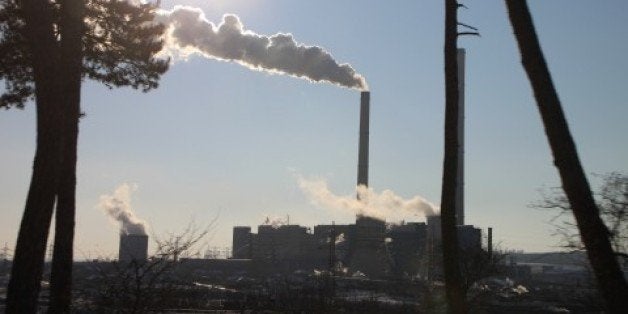
The EPA's proposed Clean Power Plan drew praise from environmental advocates who have long hoped that Washington would finally take action to limit greenhouse gas emissions and address the threat of climate change. Criticism, perhaps predictably, came from a combination of climate change deniers, coal-reliant communities worried about potential job loss, and business interests bemoaning possible higher energy costs.
Citing the cost issue as it joined the chorus of opposition was the National Black Chamber of Commerce. While the Black Chamber's opposition may be sincere, it also provides big business advocates with a bit of diversity cover -- striking since people of color actually stand the most to gain from the short-term public health benefits of the rule.
The reason: Reductions in carbon emissions will also reduce emissions of other pollutants, such as particulate matter, that cause problems such as asthma, cardiovascular disease and other respiratory effects, many of which disproportionately affect communities of color. These immediate public health benefits were stressed by President Obama as he tried to "sell" the EPA's proposed action.
The proposed Rule will limit power plant emissions of carbon -- which until now have remained unregulated -- by creating a "consistent national framework" to reduce carbon pollution, while granting states flexibility in how they meet federal standards in ways that are most efficient and reflective of their needs. Because of this, the EPA's proposal gives state-specific carbon emission targets that they will then meet individually or in regional groups -- with carbon trading as one option on the table.
Carbon trading is already up and running in California. In a report, Minding the Climate Gap, that we prepared as the state's trading system was being booted up, we found that the major portion of particulate pollution from facilities likely to fall under the cap-and-trade system came from a small number of facilities clustered in densely populated low-income communities and communities of color.
Using California Air Resource Board and Census data, we calculated the population-weighted average particulate emissions for all people of color and non-Hispanic whites -- and the former group experienced a pollution burden that was over 70 percent higher than the latter group, with much of the difference due to emissions from petroleum refineries. In another study conducted with environmental economist, Jim Boyce, we looked at the pattern nationally -- although with slightly less complete coverage of facilities -- and also found that emissions of toxic co-pollutants from greenhouse gas emitters were much higher in communities of color.
All this suggests that the EPA's proposed rule to reduce carbon emissions -- and with them, co-pollutants like particulate matter, sulfur dioxide, nitrogen oxides, and air toxics could have enormous and immediate public health benefits for minority neighborhoods already stressed by other sorts of exposures. The economic interests of various business groups, including the Black Chamber, who publicly worry about potentially higher energy costs need to be counter-balanced with the very significant financial savings of decreased respiratory illnesses associated with reductions in harmful pollutants that disproportionately affect millions of African Americans and Latinos.
To fully realize the public health benefits of the Clean Power Plan, however, state flexibility needs to be accountable to equity concerns as well. While letting states forge their own compliance path sounds great in theory, such flexibility could actually work out poorly in practice. The reason is exactly what we found in Minding the Climate Gap: Cap-and-trade systems account for greenhouse gas emissions, but generally miss the co-pollutants that have more immediate health impacts.
To understand the problem, consider that in California, the La Paloma power plant in McKittrick and the Exxon Mobile refinery in Torrance both emit between 2.5 and 3 million tons of carbon dioxide. However, the La Paloma power plant emits 48.6 tons of particulate matter in a mostly rural area with no other emitters nearby while the Exxon Mobile plant emits 352.2 tons in a densely populated urban area with many other emitters nearby. Clearly, carbon reductions in the urban and more populated location would have far higher health benefits and associated cost savings than similar carbon reductions in the rural and lightly populated location.
Making carbon market systems more effective at pricing in all co-pollutants along with carbon emissions is easier than many might think. This is partly because the bulk of co-pollutants are associated with a handful of facilities within a few sectors, making it straightforward to limit certain kinds of carbon trades or, alternatively, price the trades (with a surcharge) to factor in the public health costs of co-pollutants. Revenues from those trades could be invested to address job development and environmental distress in the most disadvantaged areas, a legislative strategy that is currently being implemented in California.
The big point here is that the EPA was right to move ahead on addressing climate change and the president was, in our view, right to promote the proposed rule based on its immediate public health benefits. At the same time, legitimate concerns remain about whether we will leave potential health benefits unrealized if we allow states to over-rely on carbon trading, while turning a blind eye to the fact that the market is not an even playing field, particularly for people of color.
Another -- cooler and cleaner -- planet is possible and the EPA's Clean Power Plan proposal is a step in the right direction to address climate change. Yet as stakeholders debate the Plan over the next several months, it will be critical to factor in health and equity concerns, consider the distribution of gains and losses, and encourage the full participation of every community that can benefit from reducing both greenhouse gas emissions and harmful co-pollutants.
Manuel Pastor is Professor of Sociology and American Studies & Ethnicity at the University of Southern California. Rachel Morello-Frosch is Professor of Environmental Science, Policy and Management at the School of Public Health at the University of California, Berkeley.